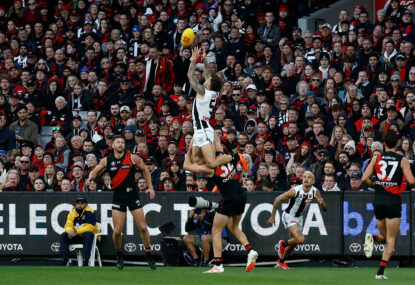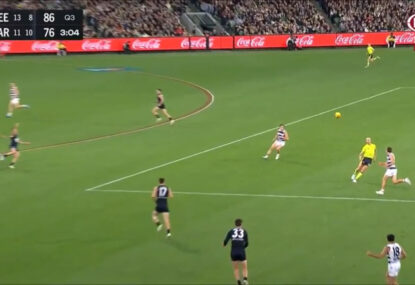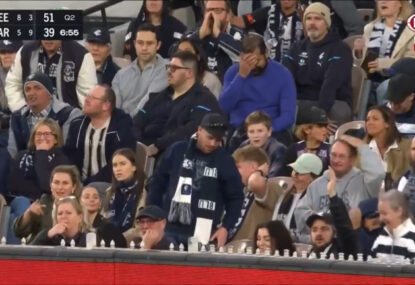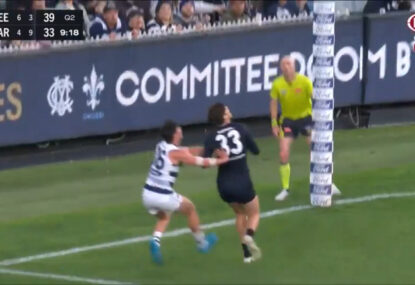
Collingwood's Nick Maxwell can't believe an umpiring decision during the AFL Round 19 match between the Geelong Cats and the Collingwood Magpies at the MCG, Melbourne.
Geelong’s Mark Blake is a ruckman of the old school variety. His game plan: come off the bench to give number one big boy Brad Ottens a rest for a few minutes, sprint to the next ruck contest as quickly as possible and tap the ball to a teammate’s advantage. Then sprint back to the bench again.
That’s it – simple yet effective.
It has worked perfectly for the Geelong Football Club during its successful dynasty over the past four years.
However, the 25-year-old’s career is now in serious jeopardy.
Blake was not selected for the Cats’ NAB Challenge match against the Blues on Saturday. It’s a strange decision, especially because his average of 19 hitouts per match over his 99-game career – one of them being a grand final victory in 2009 – is very respectable.
So why would the Cats’ match committee choose young ruck trio Trent West, Dawson Simpson and Nathan Vardy instead of Blake, in arguably their strongest line-up of the pre-season to date?
The substitution rule.
Blake was fit and eligible for selection. Yet the new rule, which introduces a substitute player and reduces the number of bench players from four to three, has been acknowledged as the possible death of the traditional backup ruckman.
West, Vardy and Simpson have all proven at VFL level they can push forward and kick goals if called upon. Blake can’t.
Unlike West Coast’s Dean Cox, Blake can’t rack up the disposals around the ground due to his poor coordination. Unlike Collingwood’s Darren Jolly, Blake struggles to kick goals when sent forward because he lacks strong hands, a decent kick and an intimidating presence.
Now, due to his inflexible nature and lack of versatility, the chances of him playing his 100th match against St Kilda in the first round of the home-and-away season seem unlikely.
Over the past few years, valuable mobile players such as Collingwood’s Leigh Brown have been used as pinch-hitting ruckman. They start on the bench or in one of the 50 metre arcs, and then push into the middle to relieve the number one big man.
Gone are the days where the big, dopey ruckman rotates on and off the bench to purely relieve his superior. They are now considered a waste of space on match day and are on the verge of extinction.
The future of AFL ruckmen is not the only issue the new sub rule will bring to the AFL.
The average number of rotations per team per game had increased from 36 in 2005 to 117 in 2010. Player welfare had become a major issue and something needed to be done about the rotation situation before it got out of hand.
Enter the sub rule again – a rule introduced this year primarily aimed to increase player fatigue, slow the tempo of the game down and decrease the number of interchanges.
North Melbourne voluntarily trialled the new system during its 13-point NAB Challenge victory over Western Bulldogs on Saturday, using three interchange players and a number of substitutes throughout the match.
Unfortunately for the Kangaroos, four key players – Brady Rawlings (hamstring tightness), Matt Campbell (hamstring strain), Aaron Edwards (corked thigh) and Sam Wright (concussion) – were injured during the match.
A couple of those players were hurt after coach Brad Scott had used up all of his substitutions during the half-time break.
The injuries restricted the Kangaroos to 80 interchanges, while the Bulldogs used almost double with 155.
Scott didn’t hold back when asked for his thoughts about the new rule after the match.
“What today highlighted is the disaster that is the substitution rule,” he said to the media.
“I’m staggered that we spend our time in the coaches’ box now managing and mitigating fatigue and injury.
“This rule was supposed to be introduced under the guise of player health and safety. Well, we’re going to see injured players having to stay out on the ground, otherwise you’ll be playing with 17 men.
“It’s really, really frustrating.”
Coaches must now choose – do you use the sub rule tactically or as an insurance policy?
As the recent North Melbourne game suggested, the safest option is to use it as an insurance policy. It’s very risky to inject the substitute player into the game in the first half or at the half-time interval. The Kangaroos had already subbed off a fit Michael Firrito, who, to Scott’s frustration, was unable to re-enter the game.
But if coaches choose to ignore potential injuries and accept the fact they are part of the game, they must first answer a number of questions if they want to use the rule tactically.
What type of player will the designated substitute be? Will they be an “impact player” who comes on at the 20-minute mark of the third quarter when the game is in the balance?
Will that player train specifically as a sub player during the week and try to replicate a match situation? Will it be the same player every week?
It will be fascinating to see how teams utilise the substitute player during the opening rounds of the home-and-away season.



































































































